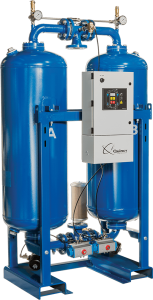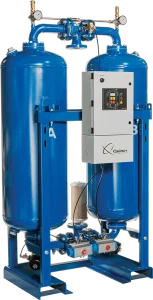

Contamination of products, disrupted manufacturing processes… physical erosion of your compressed air system. Any of these can reduce the profitability of your plant. A steady supply of ‘commercially dry’ compressed air is vital to keeping quality of products high, maintenance costs as low as possible and preventing lost productivity through downtime.
Within the dryer market there are four categories – Chemical, Refrigerated, Membrane and Regenerative Desiccant.
Regenerative desiccant dryers use adsorbents to take moisture out of the compressed air when at pressure, then once they are full the adsorbent is regenerated at low pressure. Once regenerated the adsorbent media is ready for its next use in the dryer.
This article looks at the four different types of Regenerative Desiccant Dryers, one of the more common types of dryer on the market.
Pressure Swing Regenerative Dryers.
The simplest type of dryer. Pressure swing dryers have multiple vessels where the pressure swings between the different vessels so that while one vessel is being used to dry the air the remaining vessels are regenerating their adsorbent.
No attempt is made to retain the heat of adsorption within the desiccant bed. The dryers work on short cycles of between 5 to 10 minutes before the vessels are switched. The heat adsorbed is used to desorb the moisture in the regeneration phase.
High Pressure Swing Dryers.
At higher pressures air density allows these dryers to dissipate the heat of adsorption before the end of the drying process. In High Pressure Swing Dryers, no attempt is made to retain the heat so it can be used in the regeneration process. These dryers typically operate on a 30 to 60 minute cycle time.
Unheated purge air provides the energy to regenerate the desiccant bed and we see exhaust temperatures as much as 100°F lower than the inlet temperature.
Internally Heated Regenerative Dryers.
Heaters are either clamped to the shells of the desiccant vessels or heating elements are run through the desiccant beds in this class of dryer. These dryers typically operate on four hour cycles. The only problem with internally heated regenerative dryers is desiccant must be changed-out frequently because of the hydro-thermal destruction of the adsorbent at elevated temperatures in moist environments.
Externally Heated Regenerative Dryers.
Externally heated dryers rely on the indirect heating of the wet adsorbent. In this design regeneration can be achieved at either line or atmospheric pressure. Obviously atmospheric pressure is more efficient.
Regenerative desiccant air dryers can be designed and manufactured to almost any service conditions. Before ordering make sure you review the performance of your dryer against your original design spec in partnership with your provider of choice. Nobody wants wet air!
To learn more about the various types of dryers available for your operations, click here.
If you need to upgrade your dryer or install a new compressed air system call the team at Pye-Barker on 404-363-6000 or drop us a line sales@pyebarker.com


